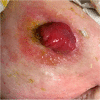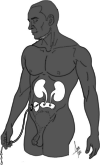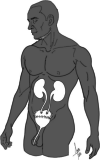Stoma-related complications and emergencies
- PMID: 35534817
- PMCID: PMC9082897
- DOI: 10.1186/s12245-022-00421-9
Stoma-related complications and emergencies
Abstract
Stoma creations are common procedures in surgical specialties. They can be created either as a temporary or a permanent measure. Despite advancements in surgical technique and stoma care, complications are common. Patients experiencing stoma-related complications often present to the emergency department. Emergency physicians are not expected to be stoma experts, yet they are often the first point of contact for patients experiencing stoma-related complications. Accordingly, emergency physicians should be familiar with the types of stomas and complications and emergencies associated with them so that they can appropriately address the problems related to stomas. This article will provide a review of emergencies and complications associated with ileostomies, colostomies, and urostomies.
Keywords: Colostomy; High-output stoma; Ileostomy; Ostomy; Parastomal herniation; Stoma; Stoma care; Stoma complications; Stoma necrosis; Stoma obstruction; Urostomy.
© 2022. The Author(s).
Conflict of interest statement
S.-C. Yeung reports grants from Bausch Health Companies, Inc., Depomed, Inc., and Bristol-Myer Squibb, and expert panel member at Celgene, Inc. outside the submitted work. All other authors declare that they have no competing interests.
Figures






Similar articles
-
The Prevalence of Ostomy-related Complications 1 Year After Ostomy Surgery: A Prospective, Descriptive, Clinical Study.Ostomy Wound Manage. 2016 Oct;62(10):34-48. Ostomy Wound Manage. 2016. PMID: 27768579
-
Thirty years of the health care service for ostomy patients in Juiz de Fora and surroundings.Rev Col Bras Cir. 2021 Jan 20;48:e20202644. doi: 10.1590/0100-6991e-20202644. eCollection 2021. Rev Col Bras Cir. 2021. PMID: 33503140 Free PMC article.
-
Intestinal stoma complications in immunocompromised children.J Pediatr Surg. 1999 Dec;34(12):1757-61. doi: 10.1016/s0022-3468(99)90306-8. J Pediatr Surg. 1999. PMID: 10626848
-
Lateral pararectal versus transrectal stoma placement for prevention of parastomal herniation.Cochrane Database Syst Rev. 2019 Apr 24;4(4):CD009487. doi: 10.1002/14651858.CD009487.pub3. Cochrane Database Syst Rev. 2019. PMID: 31016723 Free PMC article.
-
A closer look at the stoma: multimodal imaging of patients with ileostomies and colostomies.Insights Imaging. 2019 Mar 29;10(1):41. doi: 10.1186/s13244-019-0722-x. Insights Imaging. 2019. PMID: 30927144 Free PMC article. Review.
Cited by
-
The Frequency of Stoma-Related Readmissions After Emergency and Elective Ileostomy Formation: The Leicester Experience.Cureus. 2024 Nov 6;16(11):e73158. doi: 10.7759/cureus.73158. eCollection 2024 Nov. Cureus. 2024. PMID: 39650897 Free PMC article.
-
Predictive model for early postoperative stomal complications in colorectal cancer: A systematic review.World J Gastrointest Oncol. 2025 Aug 15;17(8):109405. doi: 10.4251/wjgo.v17.i8.109405. World J Gastrointest Oncol. 2025. PMID: 40837766 Free PMC article.
-
Obstructive and secretory complications of diverting ileostomy.World J Gastroenterol. 2022 Dec 21;28(47):6732-6742. doi: 10.3748/wjg.v28.i47.6732. World J Gastroenterol. 2022. PMID: 36620340 Free PMC article. Review.
-
Prevalence and pooled risk factors of stoma outlet obstruction after colorectal surgery with diverting ileostomy: a systematic review and meta-analysis.Int J Colorectal Dis. 2025 May 15;40(1):119. doi: 10.1007/s00384-025-04862-5. Int J Colorectal Dis. 2025. PMID: 40374916 Free PMC article. Review.
-
Surgical Site Infection After Stoma Reversal: A Comparison Between Linear and Purse-String Closure.Cureus. 2023 Dec 6;15(12):e50057. doi: 10.7759/cureus.50057. eCollection 2023 Dec. Cureus. 2023. PMID: 38186536 Free PMC article.
References
Publication types
LinkOut - more resources
Full Text Sources

